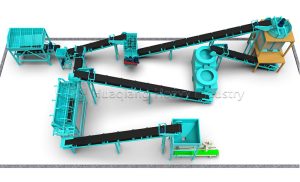The production process of granular organic fertilizer mainly includes the following key steps:
1. Preliminary preparation.Raw material collection and pretreatment: Collect organic waste such as livestock and poultry manure and crop straw as raw materials. The raw materials need to be pretreated, such as adjusting the moisture content (generally controlled at 55%65%) and the carbon-nitrogen ratio (usually adjusted to 2530) to ensure the fermentation effect.
2. Fermentation and maturity.Aerobic fermentation: Add an appropriate amount of fermentation bacteria to the pretreated raw materials and perform aerobic fermentation through a turning machine. During the fermentation process, the temperature of the pile should be controlled at around 65°C to kill parasite eggs, pathogens and weed seeds to achieve harmless standards. The fermentation time depends on the type of raw materials and temperature conditions, and generally takes several weeks to several months.
Aeration and turning: During the fermentation process, aeration is performed as needed to increase the oxygen content and improve the fermentation effect. At the same time, the turning machine is used to turn the pile regularly to promote uniform fermentation of the material.
Composting and aging: After fermentation, the material needs to enter the composting stage to further decompose the macromolecular organic matter into small molecular structures to improve the fertilizer efficiency. This stage can be achieved by natural stacking or turning over again.
3. Crushing and screening.Crushing: Crushing the composted material to remove large impurities and refine the particles for subsequent granulation.
Screening: The crushed material is graded by screening equipment to remove fine particles and impurities that do not meet the requirements.
4. Batching and mixing.Batching: Batching the raw materials according to product standards and market demand to ensure that the nutrient content of the finished organic fertilizer meets the relevant standards.
Mixing: Use a mixer to fully mix the batched raw materials to ensure that the nutrient distribution of the finished organic fertilizer is consistent.
5. Granulation and drying.Granulation: Use equipment such as a drum granulator or a disc granulator to granulate the evenly mixed materials to form granular organic fertilizer. During the granulation process, an appropriate amount of water can be added as needed to increase the particle forming rate.
Drying: The moisture content of organic fertilizer granules after granulation is high (generally 35%~45%), and the moisture content needs to be reduced to less than 20% through drying equipment (bio-organic fertilizer needs to be reduced to less than 15%). The temperature and time should be controlled during the drying process to avoid carbonization of organic matter and nitrogen evaporation loss.

6. Cooling and screening.Cooling: The dried organic fertilizer granules need to be cooled to reduce the temperature and prevent agglomeration.
Screening: The cooled granules need to be screened again to remove broken granules and impurities to ensure the quality of the finished product.
7. Coating and microbial agent addition (optional).Coating: To improve the appearance and color of the finished granules, coating can be performed.
Bacterial agent addition: If bio-organic fertilizer is produced, various microbial agents can be added during the coating process to enhance the fertilizer effect.
8. Packaging and storage.The processed granular organic fertilizer is packaged and sent to the finished product warehouse for storage or directly loaded and sold.
In summary, the production process of granular organic fertilizer includes the steps of raw material collection and pretreatment, fermentation and decomposition, crushing and screening, batching and mixing, granulation and drying, cooling and screening, coating and bacterial agent addition (optional), etc. These steps together ensure the quality and fertilizer efficiency of granular organic fertilizer.


